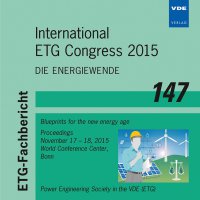Controlled Reactive Power Provision at the Interface of Medium- and High Voltage Level: First Laboratory Experiences for a Bayernwerk Distribution Grid using Real-Time-Hardware-in-the-Loop-Simulation
Conference: International ETG Congress 2015 - Die Energiewende - Blueprints for the new energy age
11/17/2015 - 11/18/2015 at Bonn, Germany
Proceedings: International ETG Congress 2015
Pages: 8Language: englishTyp: PDF
Personal VDE Members are entitled to a 10% discount on this title
Authors:
Wang, Haonan; Stetz, Thomas; Marten, Frank; Kraiczy, Markus; Braun, Martin (Fraunhofer Institute IWES, Königstor 59, 34119 Kassel, Germany)
Schmidt, Sebastian; Bock, Carsten (Bayernwerk AG, Regensburg, Germany)
Braun, Martin (University of Kassel, Department of Energy Management and Grid Operation, Kassel, Germany)
Abstract:
Changing reactive power behaviors of distribution systems (e.g., due to higher degrees of cabling and local reactive power provision through distributed generators (DGs)) together with the loss of generator-based reactive power sources at transmission system level may lead to an increased demand of reactive power flexibilities in the distribution grid. Some distribution system operators (DSOs) are therefore interested in using the reactive power control capabilities of DGs in the distribution system to provide a certain amount of controlled reactive power exchange at network interfaces. A previous study introduced a central reactive power management (Q-Management) algorithm, which aims at controlling the reactive power exchange at the interface of medium and high voltage (MV/HV) levels by utilizing the reactive power control capabilities of distributed generators at MV level. In this study, the functionality and stability of this proposed central Q-Management is further investigated in laboratory environment through a real-time Hardware-in-the-Loop simulation. It was found that the central Q-Management shows reliable and stable behavior with satisfactory control accuracy. Furthermore, although no online information of local DGs is gathered from the distribution system operator, operation points of the associated DGs can be still limited within the predefined operation area by using a local Q(V)-limitation concept, which sufficiently supports the local voltage stability. The proposed central control approach could be a solution for DSOs, who are facing reactive power issues at network interfaces to the next higher voltage level and who have access to sufficient amounts of controllable reactive power from DGs.


